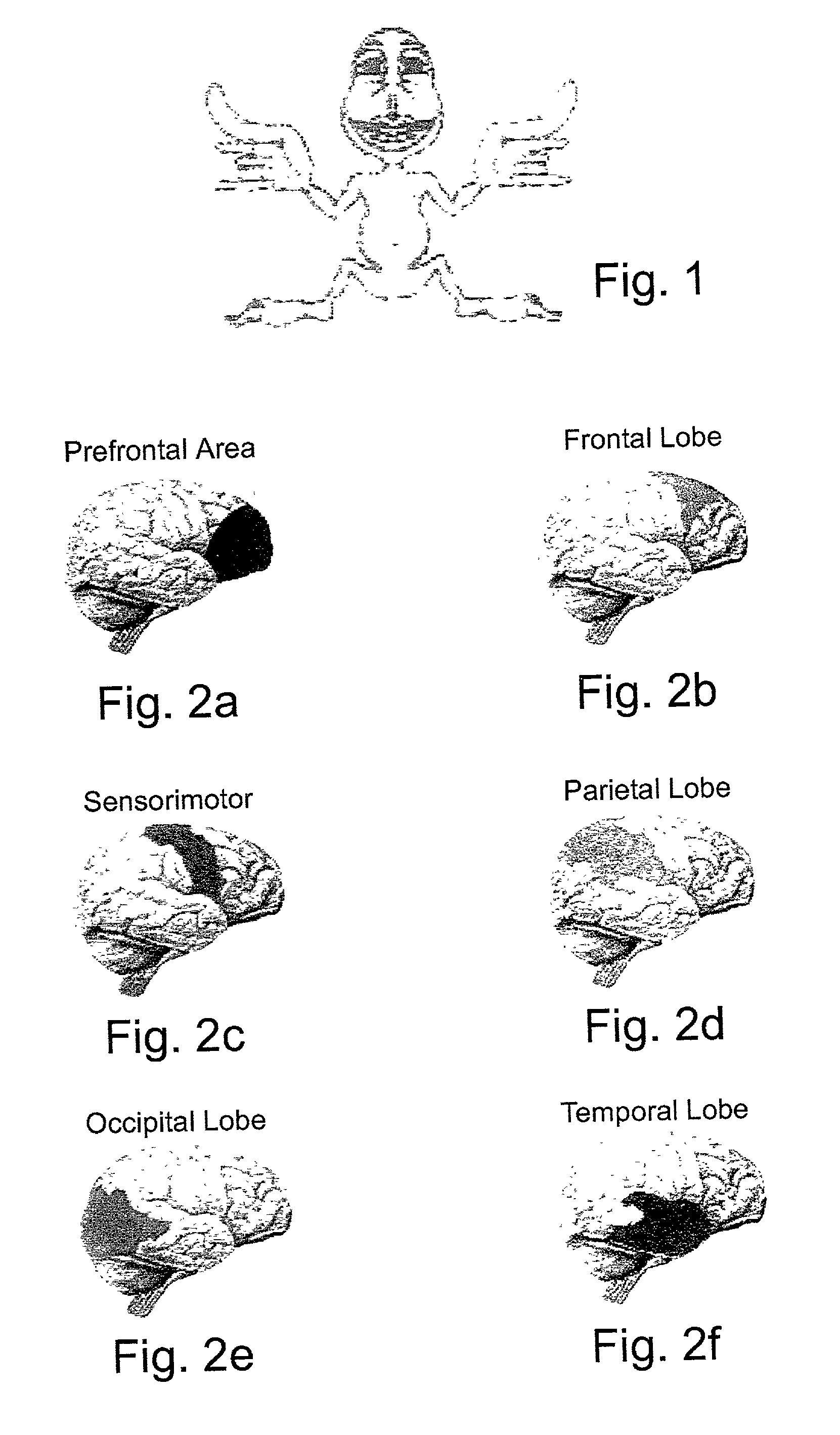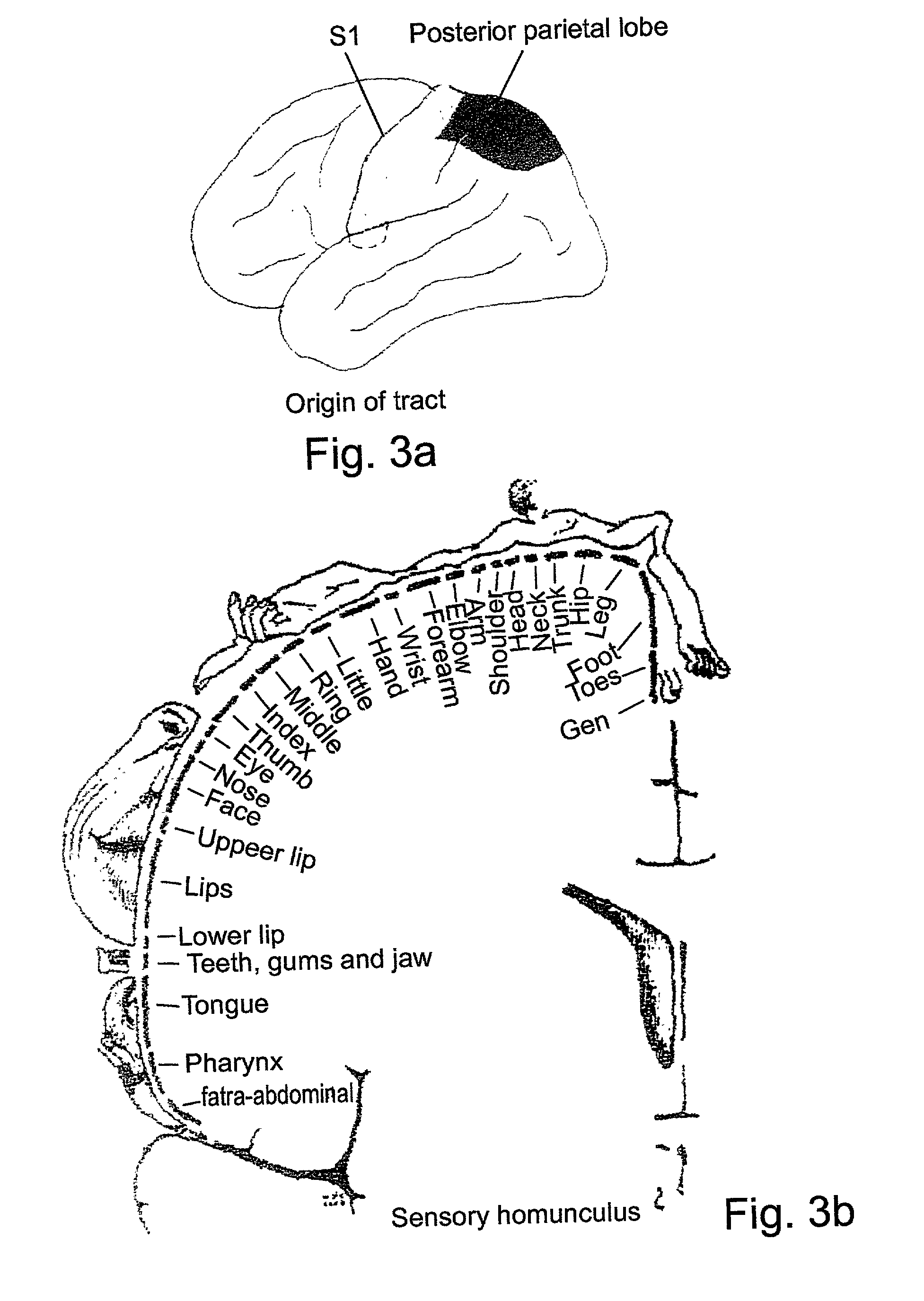System and method for functional brain mapping and an oxygen saturation difference map algorithm for effecting same
a functional brain and map algorithm technology, applied in the field of system and method of functional brain mapping and oxygen saturation difference map algorithm, can solve the problems of complex tasks involving more such distinct areas, risk of permanent brain damage to the patien
- Summary
- Abstract
- Description
- Claims
- Application Information
AI Technical Summary
Problems solved by technology
Method used
Image
Examples
example 1
fMRI vs. Exposed Cortex Images Obtained via Spectral Imaging
[0370] This example demonstrates the difference between preoperational images (be it CT, PET or fMRI) and the way the exposed cortex appears to the operating neurosurgeon during operation.
[0371] FIG. 14 shows a T1-weighted image acquired to localize anatomy within which evoked function will be imaged. The brain is segmented to create a binary mask for application to the fMRI image. FIG. 15 shows an fMRI image acquired during photic stimulation. FIG. 16 shows the masking of FIG. 15 with the T1 brain mask segments activity localized to the brain. As shown in FIG. 16, selection of a given threshold reveals areas of evoked response function. These fMRI images were taken from the web site of the Mayo clinic (USA), (http: / / www.mayo.edu / ) and present typical fMRI results.
[0372] FIG. 10 shows a color (RGB) image reconstituted from spectral data acquired on awake patient undergoing neurosurgery. Comparing the fMRI images of FIGS. 14...
example 2
Calculating Oxygen Saturation Difference Maps by Applying Various Thresholds
[0374] The images shown herein were derived from a 58 year-old female, diagnosed for a right parietal enhancing tumor (GBM), which underwent tumor resection under general anesthesia.
[0375] The images shown in FIGS. 17-27 are difference maps created by comparing a base image with an image acquired post left palm electrical stimulation and demonstrate the importance of using thresholds when highlighting oxygen saturation differences in accordance with the teachings of the present invention. Overall oxygen saturation values in this patient are low and represent a typical values of a patient under general anesthesia. The patient was respirated and monitored with the following physiological parameters:
[0376] Respiration Rate--10 per minute
[0377] Total Volume--0.7 liter
[0378] Blood Pressure--125 / 60
[0379] End Tidal CO.sub.2--30 mmHg
[0380] Medication: Remphentanil 0.18 .mu.l / kg / minute; Propofol 30 mg / hour.
[0381] FIG...
example 3
Wernike's Area Mapping During Awake Craniotomy
[0394] An 80 years old male diagnosed with lung cancer 12 years prior to admission for a left temporal cystic lesion (found to be a metastasis). The patient suffers from cognitive dysfunction (anterograde amnesia) and dysphasia. fMRI imaging showed Wernike's Area to be located adjacent to the tumor on the Superior Temporal Gyros (STG), see FIGS. 28-30.
[0395] FIG. 28 shows an fMRI image demonstrating the activation of Wernike's area (the orange spot on the right. FIG. 29 is a CT image showing a section of the brain, the tumor is clearly seen on the right-hand side (actually the left hemisphere of the brain). FIG. 30 is a gray-scale orientation image as observed by the spectral imaging device employed.
[0396] The patient underwent awake craniotomy for tumor resection. Physical parameters during craniotomy:
[0397] OS 100% --measured using pulse oxymeter on toe.
[0398] PCO.sub.2--38
[0399] BP 80 systole
[0400] Medication at this stage:
[0401] Prop...
PUM
 Login to View More
Login to View More Abstract
Description
Claims
Application Information
 Login to View More
Login to View More - R&D
- Intellectual Property
- Life Sciences
- Materials
- Tech Scout
- Unparalleled Data Quality
- Higher Quality Content
- 60% Fewer Hallucinations
Browse by: Latest US Patents, China's latest patents, Technical Efficacy Thesaurus, Application Domain, Technology Topic, Popular Technical Reports.
© 2025 PatSnap. All rights reserved.Legal|Privacy policy|Modern Slavery Act Transparency Statement|Sitemap|About US| Contact US: help@patsnap.com



